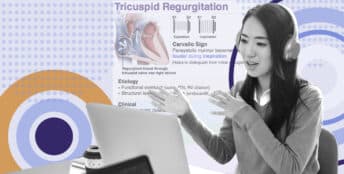What Is Subject-Verb Agreement and How Do You Do It?

This month’s topic is how to make your subjects and verbs agree. Think of yourself as a grammatical mediator—your job is to make everyone get along and play nice. This means singular subjects should have singular verbs, and plural subjects should have plural verbs. Sounds simple, but this can be surprisingly difficult once you add words between the subject and the verb.
First the basics: the subject of a sentence is the noun (the thing) that is doing something (the verb). Let’s start off by identifying the subject and the verb in a sentence. Tip: look for the action word and then find the thing that’s doing the action.
The PA student studied all month for the PANCE.
What is the action word in this sentence? Studied. Who studied? The PA student. Great, you’ve identified the subject and the verb! Let’s try another example.
This NP Certification Exam Qbank boosts my confidence.
Time to identify the subject and the verb. Remember, if you’re stuck, look for the action word and figure out which noun is doing that action. What is the verb in this sentence? Boosts. And which noun (thing) in our sentence is boosting? The Qbank.* And now the topic of subject-verb agreement comes in. Since we only have one Qbank, we use the singular form of the verb: boosts.**
A singular subject takes a singular verb, and similarly, a plural subject (more than one) needs a plural verb.
Nurse practitioner Qbanks make great study tools for NP students.
Feeling ok about this? Let’s ramp it up a bit.
Other risk factors of chronic pancreatitis [includes/include] cholelithiasis, peptic ulcer disease, hyperparathyroidism, hyperlipidemia, pancreatic obstruction, autoimmune and genetic disorders, and toxic metabolites.
I’ve highlighted the verb here for you—should it be singular or plural? Depends on our subject. Since we know the sentence’s verb, the subject will be the noun that’s doing the verb.
We have two nouns in the beginning of the sentence: “risk factors” (would take the verb “include”) and “pancreatitis” (would take the verb “includes”). Are the risk factors including something or is the pancreatitis including something? The risk factors. Notice the word “of”? It indicates that chronic pancreatitis is further describing which risk factors we’re looking for and, therefore, is NOT the subject of this sentence. Since “risk factors” is plural, include is the correct form of the verb.
Other risk factors of chronic pancreatitis include cholelithiasis, peptic ulcer disease, hyperparathyroidism, hyperlipidemia, pancreatic obstruction, autoimmune and genetic disorders, and toxic metabolites.
The easiest way for me to make sure my subjects and verbs agree is to remove the words between them. Since we know “risk factors” is the subject and “include/includes” is our verb, removing the words between them leaves “Other risk factors…include cholelithiasis, peptic ulcer disease…”—distractors are no longer in the way.
How about this example from AMA?
A review of all patients with grade 3 tumors [were/was] undertaken in the university hospital.
Let’s take a similar tactic to the last example (I’ve highlighted the verb for you again):
- Find the sentence’s subject
This time we have three nouns before the verb: review, patients, and tumors. (I know “review” is also an action word, but in this case it’s a noun—we’re clued in by the article “a” in “A review.”) What’s even more tricky is that two of those nouns are plural while one is singular! Which one is being undertaken? A review. Once again, we have an “of” indicating that “all patients with grade 3 tumors” is referring to review—the patients and their tumors are not the focus of the sentence. - Remove the words between the subject and the verb. We’re left with “A review…was/were undertaken in the university hospital,” and our answer is clear.
A review of all patients with grade 3 tumors was undertaken in the university hospital.
There we have it: how to make sure your subjects and your verbs agree.
- Identify the subject and verb (the noun and the action it’s doing)
- Remove any words between the subject and verb
- Match ’em up!
* If you were distracted by “NP Certification Exam,” that phrase describes the Qbank. You could consider “NP Certification Exam Qbank” the entire subject.
**Singular verbs commonly end in “s” or “es” and plural verbs do not—the opposite of singular and plural nouns.





Comments (0)